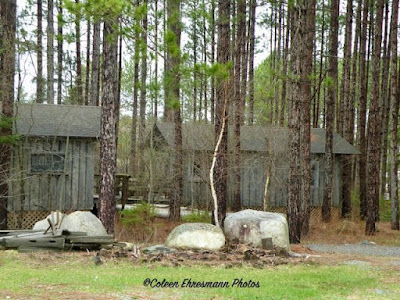Why Ely (EE-lee) MN? Well, our friends Jon & Sherry had reservations to camp and canoe in the Boundary Waters Canoe Area Wilderness this week. Unfortunately ice-off did not happen until just last weekend after Jon cancelled his BWCAW reservation. We chose to continue with the plan because we wanted to geocache in the 14 northern MN counties. We've had reservations for this trip for two months.
So what is there to see and do in Ely if you are NOT a BWCAW enthusiast?
according to the Ely Visitor Center
an interesting root system on this tree
There are miles and miles of trails for hiking and biking, often around the shore of one of the many, many lakes in this region. These trails also offer options for winter sport enthusists. This trail led to a waterfall.
International Wolf Center
wolf statues at the visitor center
For a nominal fee, you can stand behind a glass wall and watch resident gray wolves communicate, play, hunt and eat. The center also offers weekend and week-long adventures to other northern MN areas to learn about wolves.
Teaching the world about wolves
And if you are a true nature enthusiast and animal lover, you might want to visit...
North American Bear Center
where you can also view from the other side of a glass wall four resident bears in a 2.5 acre natural habitat of forested pond and waterfalls to learn more about bear behavior, ecology and their interaction with humans.
Fur trappers were the first 'white' residents to the area. Then came the miners looking for gold but instead found iron. (This area is part of the Minnesota Iron Range.) Then the lumber industry took off because the mines needed wooden supports and beams to prevent cave in and as more people came lumber was needed to provide homes and businesses. At one time there were 11 operating mines in the Ely area. The first, largest and most productive Pioneer Mine operated until 1967. The early lumber logging and milling industry depleted the area's tree reserves by the 1920s. Logging continues today on a limited scale for paper pulp.
So with the trapping, mining and logging industries declining, what did Ely have to support its residents and attract visitors? Water and lots of it.
Ely is best known as a popular entry point for the Boundary Waters Canoe Area Wilderness and Quetico Provincial Park and has cashed in on the necessary equipment and licensing required for enthusiasts to fish or canoe (or other water craft) on the many, many lakes and waterways of the area. Ely's main street is lined with outfitters, outdoor clothing stores, and restaurants. Ely is 16 miles from the Canadian border.
We have driven around the area and have noted the numerous lodges and resorts to accommodate the summer and winter visitors. The community of 3300 residents have adapted to the changes in its commerce history.

We are staying at a lodge overlooking one of the many lakes at Ely. This is the view from our window.
The lodge has a restaurant and bar which we have really appreciated during our stay. We chose to order breakfast on Thursday, our more relaxed day on this adventure. I ordered the Grand Stuffed Potatoes.
Crispy hash browns stuffed with peppers, onions, mushrooms, and shredded cheddar cheese.
- With bacon, sausage or ham. (extra cost of course)
It was delicious and the BEST hash brown breakfast dish I have ever ordered. And it was more than I could eat! All of our meals have been excellent. No more food photos.
And an interesting bit of history about the Root Beer Lady.
two of the four resort cabins
Dorothy Molter lived for 56 years on Knife Lake in the BWCAW. She gradually gained national prominence and extensive coverage in media, books and documentaries, and over the years tens of thousands of canoeists stopped by to visit and drink her homemade root beer. Molter first visited her future home (The Isle of Pines Resort) on Knife Lake in 1930 and it became her home in 1934. Until the mid/late 1940s, the Isle of Pines resort was typical of many north woods resorts. It was reachable by seaplanes and motorboats, and later by snowmobiles as they came into use.
After the BWCAW was designated, nearly all motorized transportation to Molter's lodge was eliminated, and residences, buildings, business and the few roads from the wilderness were removed, leaving Molter as the only full-time resident in a wilderness area three times the size of Rhode Island. After her death, her cabin was dismantled and moved to Ely. Her residence and a second cabin of hers were reconstructed there, and the Dorothy Molter Museum was established to preserve her legacy.

Dorothy died in 1986 at the age of 79. She was the last permanent resident of the BWCAW, living alone 18 miles and 6 portages from the closest road. Throughout the year people as many as 7000 would travel by paddle-canoe, skis or dogsled to visit the woman of the wilderness, drink some root beer or lodge in one of the four resort cabins. She was a registered nurse and would administer first aid to those in need.
I have given a very short synopsis of Dorothy Molter. To read more about this amazing, untraditional, trailblazing woman, here are three links:
The Isle of Pines
And once again, we would not have known or cared about Dorothy Molter if not for geocaching.













No comments:
Post a Comment
Thanks for your comments!